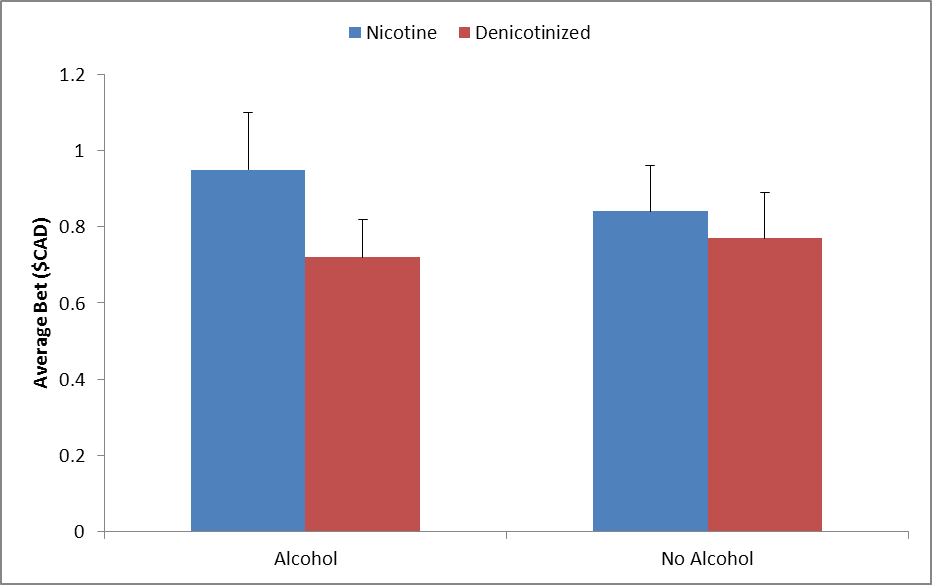ASHES, Vol. 11(3) – Up in smoke: How nicotine affects betting behavior
Smoking and alcohol use are commonplace among gamblers and at gambling establishments. Moreover, studies have shown higher rates of tobacco and alcohol dependence among people with gambling problems than in the general population (Petry et al., 2005; Kessler et al., 2008). However, little is known about the direct effects of tobacco and alcohol on gambling behavior. This week, as part of our Special Series on Gambling Disorders, we review an article that investigated the effects of nicotine and alcohol on video-lottery terminal (VLT) gambling behavior (Barrett et al., 2015).
Methods
- The researchers recruited participants through local newspaper advertisements (n=16; 11 male).
- Inclusion criteria included regular moderate alcohol use, regular VLT play, current daily smoking, and adult age (19 years in Nova Scotia).
- Each participant engaged in four VLT gambling sessions, consuming different substances each time:1
- Participants drank three beverages which contained cranberry juice and either a standard amount of alcohol or trace amounts of alcohol (applied to the rim to provide the odor and taste of alcohol).
- Participants smoked either a denicotinized cigarette (containing virtually no nicotine) or a nicotine-containing cigarette.2
- The researchers used the non-alcoholic drinks and denicotinized cigarettes as placebos to distinguish between the effects of the substance (alcohol or nicotine) from the sensory and behavioral aspects of drinking/smoking.
- The researchers conducted analyses on the entire sample (n=16) and then repeated the analysis on the 12 participants who completed all four sessions (i.e., alcohol/nicotine cigarette, alcohol/ denicotinized cigarette, no alcohol/nicotine cigarette, no alcohol/denicotinized cigarette).
- The researchers measured average bet and number of bets during VLT gambling simulations:
- Participants were given $40 each session to play a video-simulated slot machine game for as long as they wished over two 15-minute periods.
- Bets could be any size between 5 cents to $2.50.
- Participants kept whatever money was left (including winnings) after the VLT session.
Results
- Participants in both nicotine cigarette conditions (i.e., nicotine/alcohol and nicotine/no alcohol) placed significantly higher average bets than those in the denicotinized cigarette conditions (see Figure 1).
- The presence of alcohol, alone or in combination with nicotine, did not affect average bet amounts.
- Neither nicotine nor alcohol, alone or in combination, influenced average number of bets.
Figure 1. Average bet size in each drinking and smoking condition (adapted from Barrett et al., 2015). Click image to enlarge.
Limitations
- Due to the small sample size, the study might not have the statistical power to detect weaker, but real, effects.
- Participants were recruited through local newspapers. This might bias the sample toward an older population.
- Participants might have been able to distinguish between placebo cigarettes and real cigarettes, and placebo beverages and alcohol beverages. This would make it difficult to conclude with certainty that effects are due to the substance, rather than the associated sensory/behavioral experience.
Conclusions
This study reveals that smoking nicotine cigarettes results in larger bets in VLT gambling among smokers who gamble regularly. Because the authors used a placebo smoking condition, their findings suggest that the nicotine in the cigarettes—rather than the behaviors tied with smoking– is directly responsible for this tendency to bet with higher stakes. However, some of the authors’ previous studies show that acute nicotine administered through other means did not affect VLT gambling (McGrath et al. 20123). This difference could be explained by a lower amount of nicotine delivered via inhalers or by a combination of nicotine effects coupled with the act of smoking. Further research focusing on different methods of nicotine delivery is required to clarify this effect. The current findings suggest that smoking cessation could be an important target for those hoping to reduce their gambling.
–Jed Jeng
What do you think? Please use the comment link below to provide feedback on this article.
References
Barrett, S. P., Collins, P., & Stewart, S. H. (2015). The acute effects of tobacco smoking and alcohol consumption on video-lottery terminal gambling. Pharmacology Biochemistry and Behavior, 130, 34-39.
Kessler, R. C., Hwang, I., LaBrie, R., Petukhova, M., Sampson, N. A., Winters, K. C., & Shaffer, H. J. (2008). DSM-IV pathological gambling in the National Comorbidity Survey Replication. Psychological medicine, 38(09), 1351-1360.
McGrath, D. S., Barrett, S. P., Stewart, S. H., & Schmid, E. A. (2012). The effects of acute doses of nicotine on video lottery terminal gambling in daily smokers. Psychopharmacology, 220(1), 155-161.
Petry, N. M., Stinson, F. S., & Grant, B. F. (2005). Comorbidity of DSM-IV pathological gambling and other psychiatric disorders: results from the National Epidemiologic Survey on Alcohol and Related Conditions. The Journal of clinical psychiatry, 66, 564-74.
________________
1Participants were given approximately one week between sessions. Twelve participants completed all four sessions.
2Denicotinized cigarettes had a maximum of 0.05mg nicotine while normal cigarettes contained an average of 0.60mg nicotine.
3Nicotine delivered via inhaler, Video simulated slots. Initial funds: $60.
